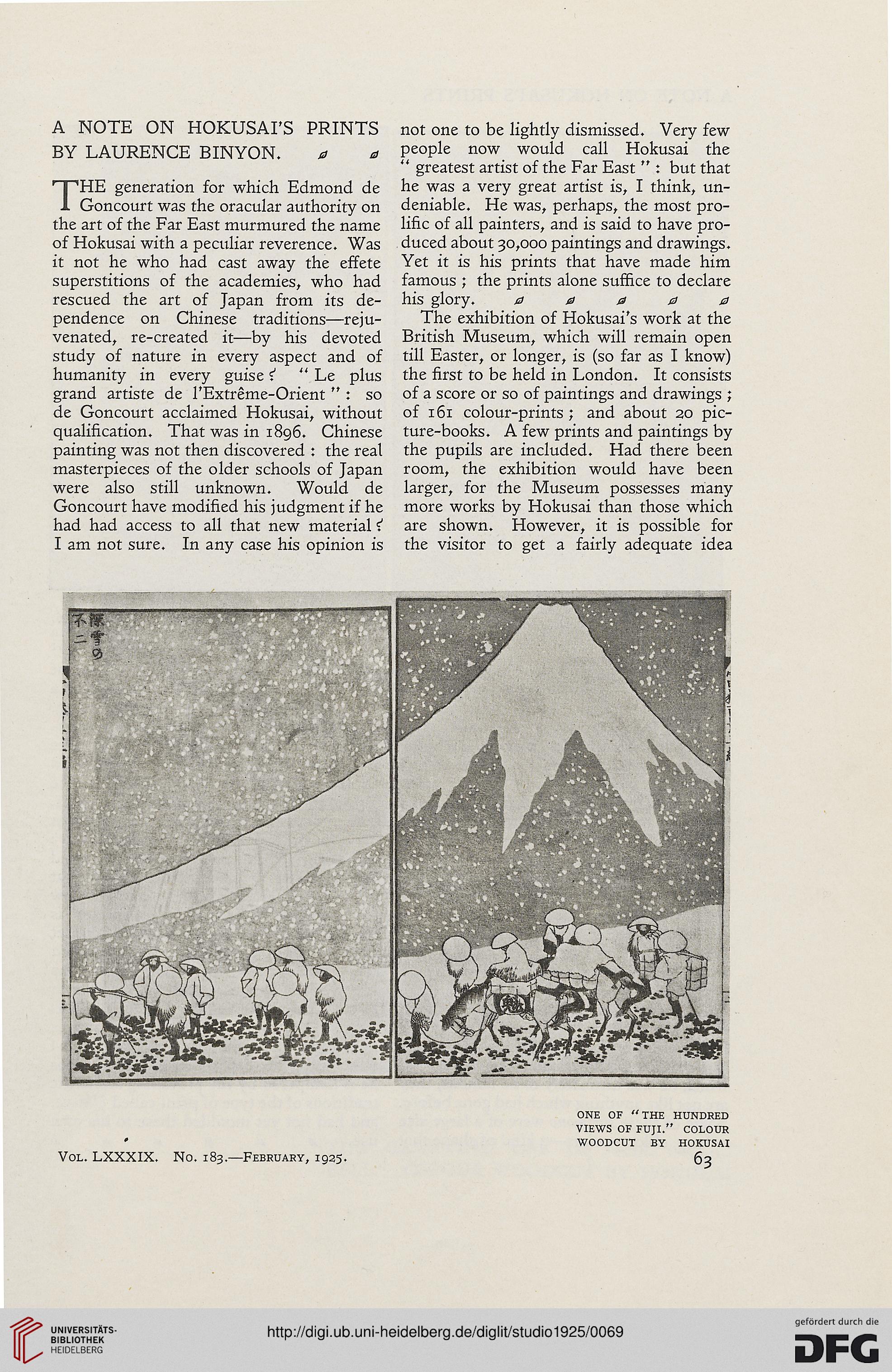A NOTE ON HOKUSAI'S PRINTS
BY LAURENCE BINYON. 0 0
THE generation for which Edmond de
Goncourt was the oracular authority on
the art of the Far East murmured the name
of Hokusai with a peculiar reverence. Was
it not he who had cast away the effete
superstitions of the academies, who had
rescued the art of Japan from its de-
pendence on Chinese traditions—reju-
venated, re-created it—by his devoted
study of nature in every aspect and of
humanity in every guise i " Le plus
grand artiste de l'Extreme-Orient " : so
de Goncourt acclaimed Hokusai, without
qualification. That was in 1896. Chinese
painting was not then discovered : the real
masterpieces of the older schools of Japan
were also still unknown. Would de
Goncourt have modified his judgment if he
had had access to all that new material i
I am not sure. In any case his opinion is
not one to be lightly dismissed. Very few
people now would call Hokusai the
" greatest artist of the Far East " : but that
he was a very great artist is, I think, un-
deniable. He was, perhaps, the most pro-
lific of all painters, and is said to have pro-
duced about 30,000 paintings and drawings.
Yet it is his prints that have made him
famous ; the prints alone suffice to declare
his glory. a 0 a a 0
The exhibition of Hokusai's work at the
British Museum, which will remain open
till Easter, or longer, is (so far as I know)
the first to be held in London. It consists
of a score or so of paintings and drawings ;
of 161 colour-prints ; and about 20 pic-
ture-books. A few prints and paintings by
the pupils are included. Had there been
room, the exhibition would have been
larger, for the Museum possesses many
more works by Hokusai than those which
are shown. However, it is possible for
the visitor to get a fairly adequate idea
BY LAURENCE BINYON. 0 0
THE generation for which Edmond de
Goncourt was the oracular authority on
the art of the Far East murmured the name
of Hokusai with a peculiar reverence. Was
it not he who had cast away the effete
superstitions of the academies, who had
rescued the art of Japan from its de-
pendence on Chinese traditions—reju-
venated, re-created it—by his devoted
study of nature in every aspect and of
humanity in every guise i " Le plus
grand artiste de l'Extreme-Orient " : so
de Goncourt acclaimed Hokusai, without
qualification. That was in 1896. Chinese
painting was not then discovered : the real
masterpieces of the older schools of Japan
were also still unknown. Would de
Goncourt have modified his judgment if he
had had access to all that new material i
I am not sure. In any case his opinion is
not one to be lightly dismissed. Very few
people now would call Hokusai the
" greatest artist of the Far East " : but that
he was a very great artist is, I think, un-
deniable. He was, perhaps, the most pro-
lific of all painters, and is said to have pro-
duced about 30,000 paintings and drawings.
Yet it is his prints that have made him
famous ; the prints alone suffice to declare
his glory. a 0 a a 0
The exhibition of Hokusai's work at the
British Museum, which will remain open
till Easter, or longer, is (so far as I know)
the first to be held in London. It consists
of a score or so of paintings and drawings ;
of 161 colour-prints ; and about 20 pic-
ture-books. A few prints and paintings by
the pupils are included. Had there been
room, the exhibition would have been
larger, for the Museum possesses many
more works by Hokusai than those which
are shown. However, it is possible for
the visitor to get a fairly adequate idea




